The University of the Self #78
Birdsong, Botany and Betterness Part 8
This article is a continuation of part 7, which can be found here.
Read article 9 here.
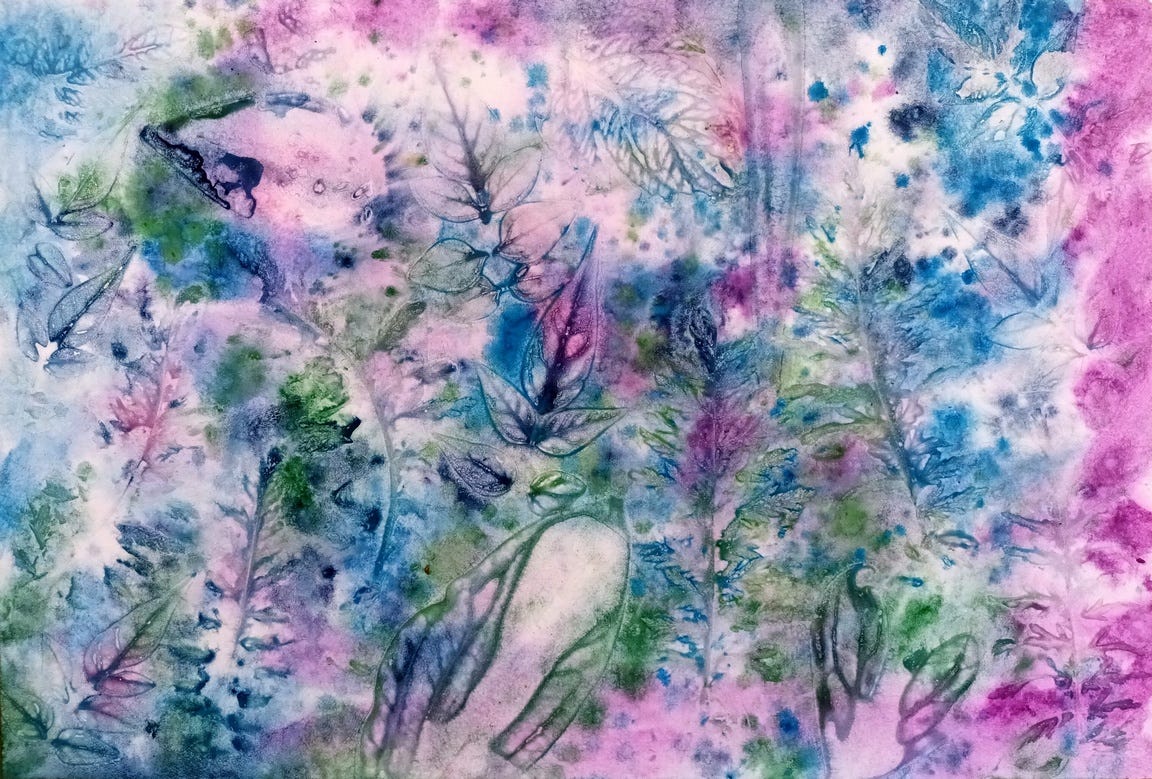
Above is the first of a pair of watercolour leaf prints I made as part of my botany noticings.
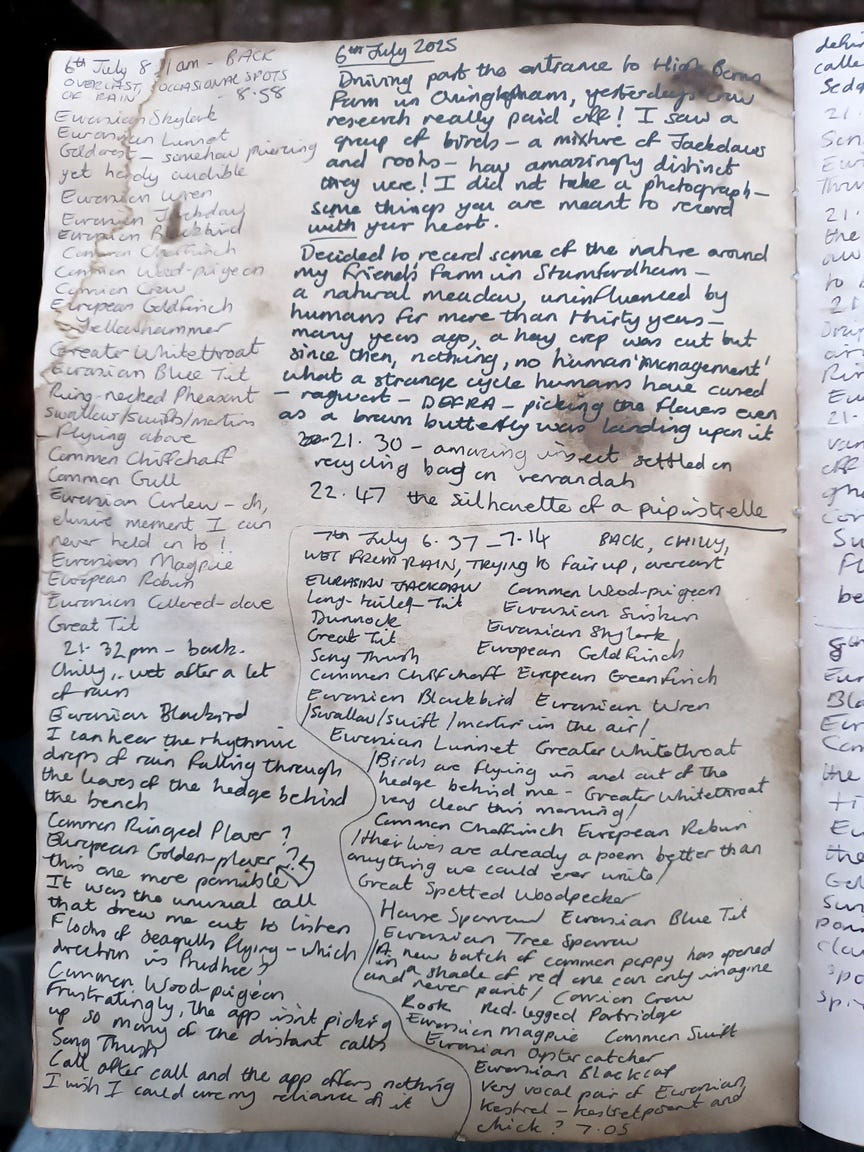
6th July, 8.11 – 8.58 a.m. Back. Overcast, occasional spots of rain
Eurasian Skylark, Eurasian Linnet, Goldcrest (somehow piercing yet hardly audible), Eurasian Wren, Eurasian Jackdaw, Common Chaffinch, Common Wood Pigeon, Carrion Crow, European Goldfinch, Yellowhammer, Greater Whitethroat, Eurasian Blue Tit, Ring-necked Pheasant, Swallow/Swift/Martin flying above, Common Chiffchaff, Common Gull, Eurasian Curlew (oh, elusive moment I can never hold on to!), Eurasian Magpie, European Robin, Eurasian Collared Dove, Great Tit.
Driving past the entrance to High Barns Farm in Ovingham, yesterday, I saw a group of birds – a mixture of Jackdaws and Rooks – how amazingly distinct they were! I did not take a photograph – some things you are meant to record with your heart.
————————————————————————————————————
I was glad I had taken the time to study differences in corvids, and no longer lump them all together as ‘crows’. They are so different. I made a study of the heads of a Jackdaw, a Rook and Carrion Crow, setting them close together so their unique characteristics become more pronounced.
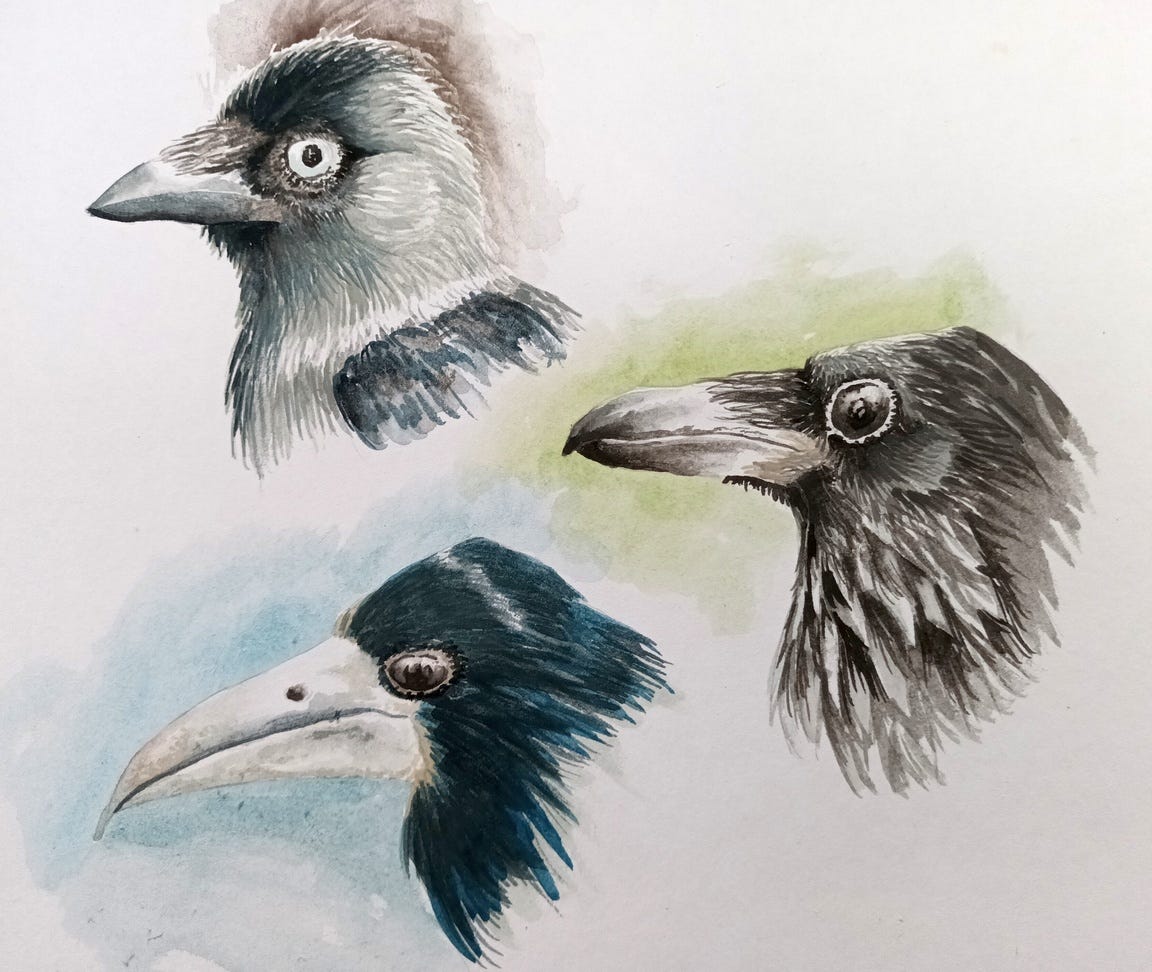
As I grow in confidence in my nature diary, I have made the decision to include more than the bird lists within it. I find that the more I list the birds, the more I wish to talk about other aspects of nature and moments from my life. I had begun to close down, to withdraw and now I feel myself opening out again, like a wing, like a flower.
————————————————————————————————————
Decided to record some of the nature around my friend’s farm in Stamfordham – a natural meadow, uninfluenced by humans for more then thirty years – many years ago, a hay crop was cut but since then, nothing, no human ‘management’. What a strange cycle humans have caused – ragwort – DEFRA – picking the flowers even as a brown butterfly was landing upon it.
————————————————————————————————————
I made the brief notes above as I knew that I wanted to expand upon them and explain a little more. For anyone that doesn’t know, ragwort is a wildflower which is now considered highly invasive. When you have had it on your land, or in your garden, or see it on a verge, you will most likely have learned how fast it grows and spreads, how impossible it seems to control, how endless the picking of it seems. Ragwort is highly toxic so if you are to handle it, please do wear protective gloves. It is toxic to horses and livestock, and so it must be cleared from grazing land. If you do not, DEFRA can issue forms asking what you are planning to do to control ragwort’s spread, and threatening monetary fines if you do not. More information on ragwort can be found here.
Here is where I wonder about the imbalances to nature humans cause - ragwort is a wildflower, and is vital for pollinating insects. It is the foodplant for the Cinnabar Moth and “…ragwort is one of the most frequently visited flowers by butterflies in the UK and more than 200 species of invertebrate have been recorded on it.”
Humans wish to own animals which live on grazing land, and this particular wildflower must suffer for it, so our animals do not. We control what is allowed to grow and where. I am doing my best to help my friend eradicate ragwort on her fields, so it does not affect the horses that we both love. My friend lives alone and has health issues of her own. It is gruelling, desperate, endless work which is having dreadful consequences on both our bodies. I cannot be there every day, and when I have helped, I am ill for a couple of days afterwards. As I mentioned in my diary entry, I picked a ragwort plant at the exact time that a butterfly landed upon one of the blooms. I felt so very sad at the act, and mused upon the intrusion of humans onto nature, and our subsequent attempts to take control of it. As the butterfly flew off, I felt sick with guilt. I have since identified the butterfly as a Ringlet. Once again, I wished to be something other than human. Humans must decide the fate of everything on Earth, it seems. Who decided that we come first?
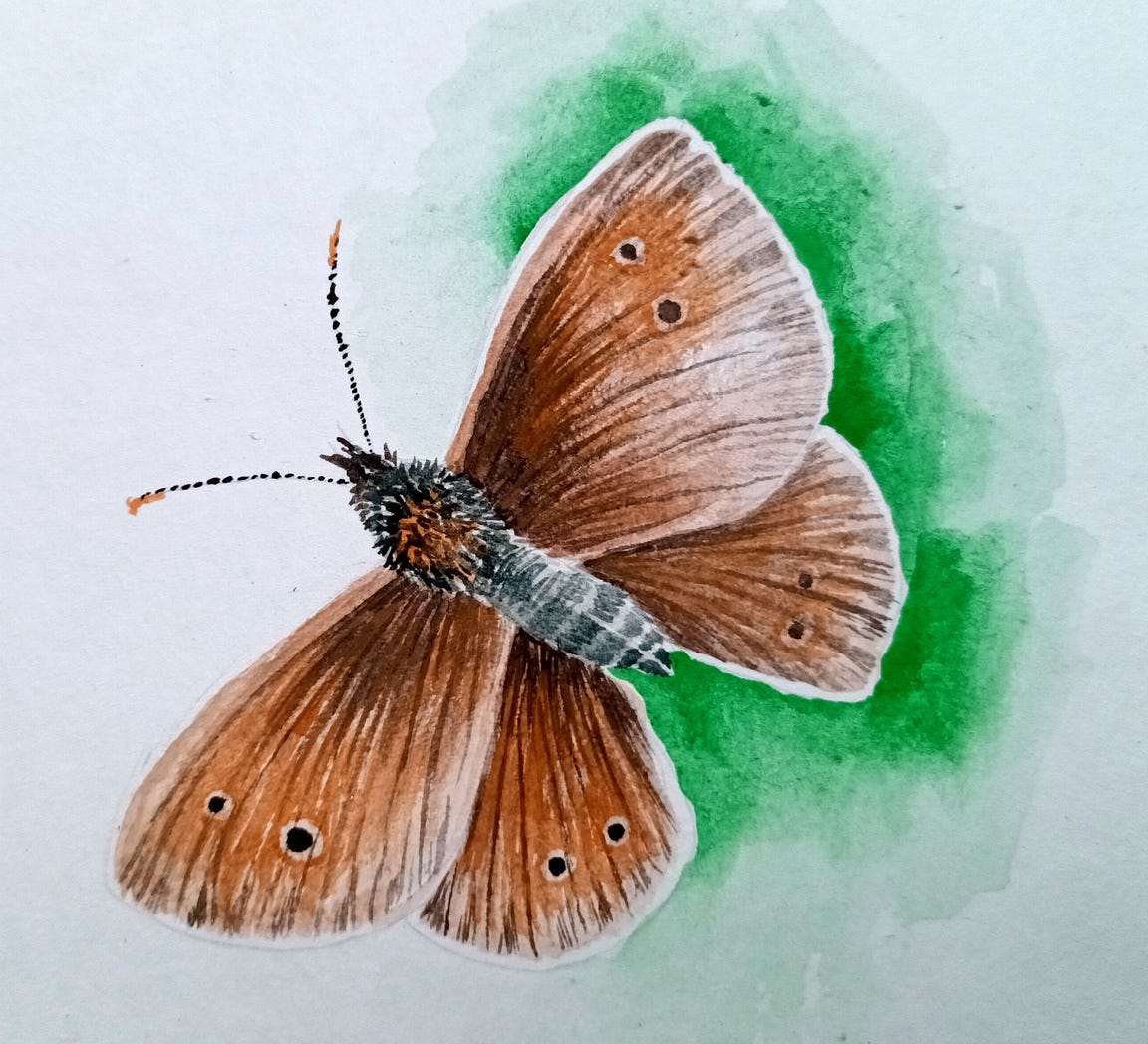
—————————————————————————————————————
21.32 p.m. Back. Chilly, wet after a lot of rain
Eurasian Blackbird.
I can hear the rhythmic drops of rain falling through the leaves of the hedge behind the bench.
Common Ringed Plover (? This one possible. It was the unusual call that drew me out to listen).
Flocks of seagulls flying…which direction is Prudhoe (another topic I must take the time to become more familiar with – the points of the compass)?
Common Wood Pigeon.
Frustratingly, the app isn’t picking up so many of the distant calls.
Song Thrush.
Call after call and the app offers nothing – I wish I could cure my reliance on it.
21.30 p.m. Amazing insect* settled on recycling bag on veranda.
22.47 p.m. The silhouette of a Pipistrelle.
——————————————————————————————————
*Research has told me that this was a type of Shield Bug, known as Forest Bug, also known as Red-legged Shield Bug. Adults can be seen from July, and it lives in woodland and gardens. It feeds upon deciduous tree sap. And trees there are a-plenty here. Its decorative trim was amazing – so distinctive. I have attempted a painting of it, to ensure I squeezed as much observation from the encounter as possible.
Shield bugs are bugs, not beetles, and they have two sets of wings – one which has hardened to create their protective shell and one which they use to fly. There are sixty varieties of Shield Bug in the UK. Apparently they can expel a pungent substance if they feel threatened.
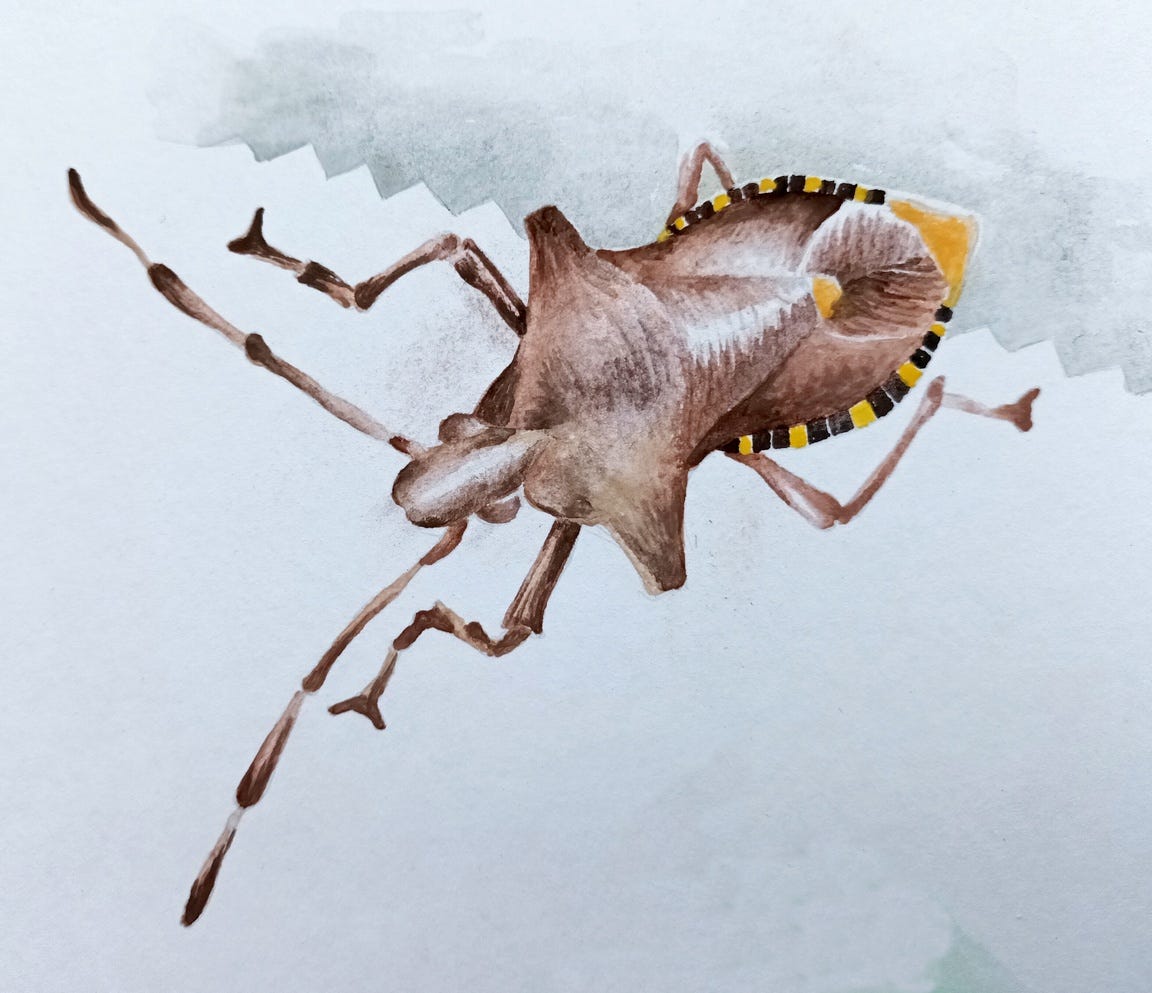
———————————————————————————————————
7th July, 6.37 – 7.14 a.m. Back. Chilly, wet from rain, trying to fair up, overcast
Eurasian Jackdaw, Common Wood Pigeon, Long-tailed Tit, Eurasian Siskin, Dunnock, Eurasian Skylark, Great Tit, European Goldfinch, Song Thrush, Common Chiffchaff, European Greenfinch, Eurasian Blackbird, Eurasian Wren, Swallow/Swift/Martin in the air, Eurasian Linnet.
Birds are flying in and out if the hedge behind me.
Greater Whitethroat song very clear this morning.
Common Chaffinch, European Robin.
Their lives are already a poem better than anything we could ever write.
Great Spotted Woodpecker, House Sparrow, Eurasian Blue Tit, Eurasian Tree Sparrow.
A new batch of Common Poppy has opened in a shade of red one can only imagine and never paint.
Carrion Crow, Rook, Red-legged Partridge (?), Eurasian Magpie, Common Swift, Eurasian Oystercatcher, Eurasian Blackbird, Eurasian Blackcap.
Very vocal pair of Eurasian Kestrel – Kestrel parent and chick? 7.05 a.m.
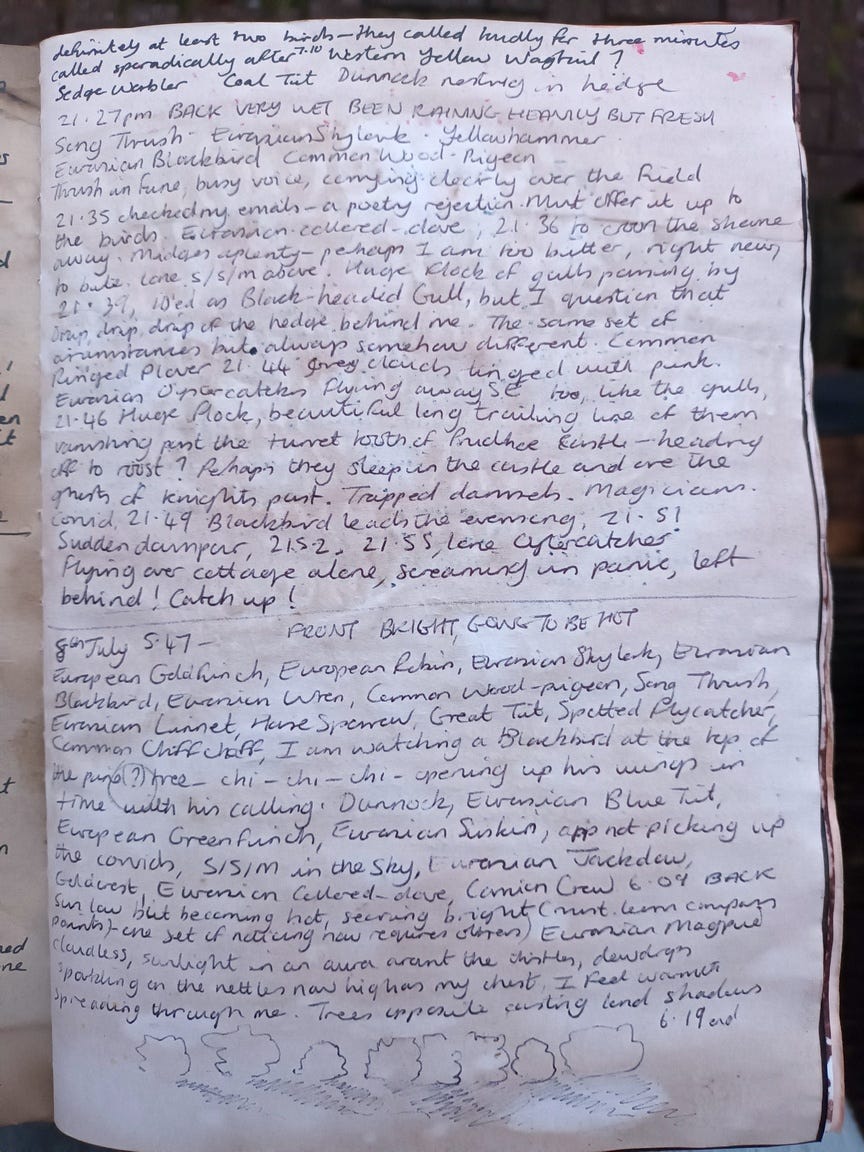
definitely at least two birds – they called loudly for three minutes, called sporadically after 7.10 a.m.
Western Yellow Wagtail (? I don’t think this is likely this far north), Sedge Warbler, Coal Tit, Dunnock nesting in hedge.
21.27 p.m. Back. Very wet, been raining heavily but fresh.
Song Thrush, Eurasian Skylark, Yellowhammer, Eurasian Blackbird, Common Wood Pigeon.
Thrush in fine, busy voice, carrying clearly over the field.
21.35 p.m. checked my emails – a poetry rejection. Must offer it up to the birds.
Eurasian Collared Dove, 21.36 p.m., to croon the shame away. Midges aplenty – perhaps I am too bitter, right now, to bite. Lone S/S/M (Swallow/Swift/Martin) above. Huge flock of gulls passing by 21.39 p.m., ID’d as Black-headed Gull, but I question that (turns out it was correct). Drip, drip, drip of the hedge behind me. The same set of circumstances but always somehow different.
Common Ringed Plover, 21.44 p.m. Grey clouds tinged with pink.
Eurasian Oystercatcher flying away SE too, like the gulls.
21.46 p.m. Huge flock, beautiful long trailing line of them (Eurasian Oystercatchers) vanishing past the turret tooth of Prudhoe Castle – heading off to roost? Perhaps they sleep in the castle and are the ghosts of knights past. Trapped damsels. Magicians.
Corvid 21.49 p.m. Blackbird leads the evensong, 21.51 p.m. Sudden downpour 21.52 p.m. 21.55 p.m., lone Oystercatcher flying over cottage alone, screaming in panic, left behind! Catch up!
8th July, 5.47 a.m. Front. Bright, going to be hot.
European Goldfinch, European Robin, Eurasian Skylark, Eurasian Blackbird, Eurasian Wren, Common Wood Pigeon, Song Thrush, Eurasian Linnet, House Sparrow, Great Tit, Spotted Flycatcher, Common Chiffchaff.
I am watching a Blackbird at the top of the pine (?) tree – chi-chi-chi – opening up his wings in time with his calling.
Dunnock, Eurasian Blue Tit, European Greenfinch, Eurasian Siskin.
App not picking up the corvids, S/S/M in the sky.
Eurasian Jackdaw, Goldcrest, Eurasian Collared Dove, Carrion Crow.
6.09 a.m. Back. Sun low but becoming hot, searing bright (must learn compass points – one set of noticing requires others). Eurasian Magpie.
Cloudless, sunlight in an aura around the thistles, dewdrops sparkling on the nettles now high as my chest. I feel warmth spreading through me. Trees opposite casting long shadows. 6.19 a.m. end.
I end today’s article with a quote from a letter written by Emily Dickinson - it echoed into my heart and resonated deeply. This is one of the reasons I have begun to carve out this time for myself – an action which may appear to serve no purpose; will earn me no renown; may even seem a useless waste to some – time taken from “…all the moments crowding this little world…”* is giving me a reason to go on, giving me reasons to fight myself. When my head tells me I am worthless, useless and hopeless; when my body hurts so much that I feel I cannot stand it; when sleeplessness exhausts me; when the efforts one makes to be a writer seem to come to naught, I turn to nature and plead for its balm, its perspective, its restorative panpharmacon.
“…a separated hour, an hour more pure and true than ordinary hours, when we could pause a moment, before we journey on.” *
*Letter written by Emily Dickinson, August, 1851.
—————————————————————————————————
Please consider helping me to keep on sharing my articles with you…
I hope you enjoyed reading my latest article. Thank you so much for spending some time here with me. Times are tough, but if you feel like supporting a struggling writer so that she can continue being able to write, (every tiny bit helps) you can do so below…
I have currently left my Substack free, but if anyone should feel like sending me a tip (although there is no pressure to do so) in exchange for my tips, you can ‘buy me a coffee’ here . Every little bit makes a big difference. Or please do subscribe, which you can do either as paid or free. Either will let you see my articles. Many thanks.
If you like the article you have read, please do click the like button — I’d love to know you are out there.
I must add the usual disclaimer here: I am not sponsored or paid by any of the websites I link to (I do this in an attempt to help others find information, and I may or may not agree/disagree with any/some of the content) — sharing does not immediately equal endorsment. I also hope I haven’t written anyting that might offend anyone. I try very hard to be as considerate and kind as possible.


Love the corvid pictures (often see all 3 from the bathroom window in the mornings. Now I might be better at telling them apart!), your notebook and your writing.
Thank you, Jane. You have the makings of a beautiful nature journal here. Wonderful - and such tender, detailed paintings xxx